My new favorite running watch. Garmin Forerunner 245 - review
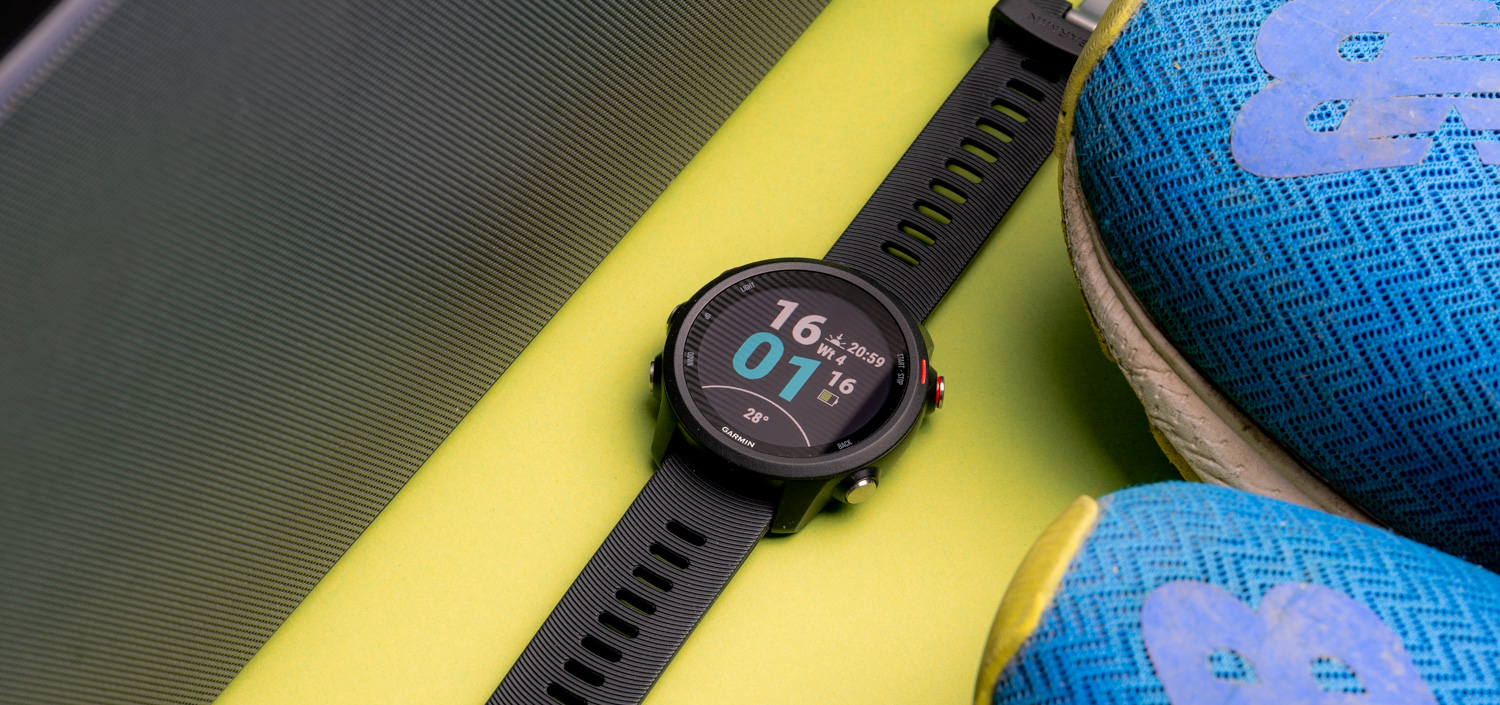
At the same time running is the key and necessary clarification here. First things first.
Let's start with what is really great.
First of all: perfect size, mass and comfort
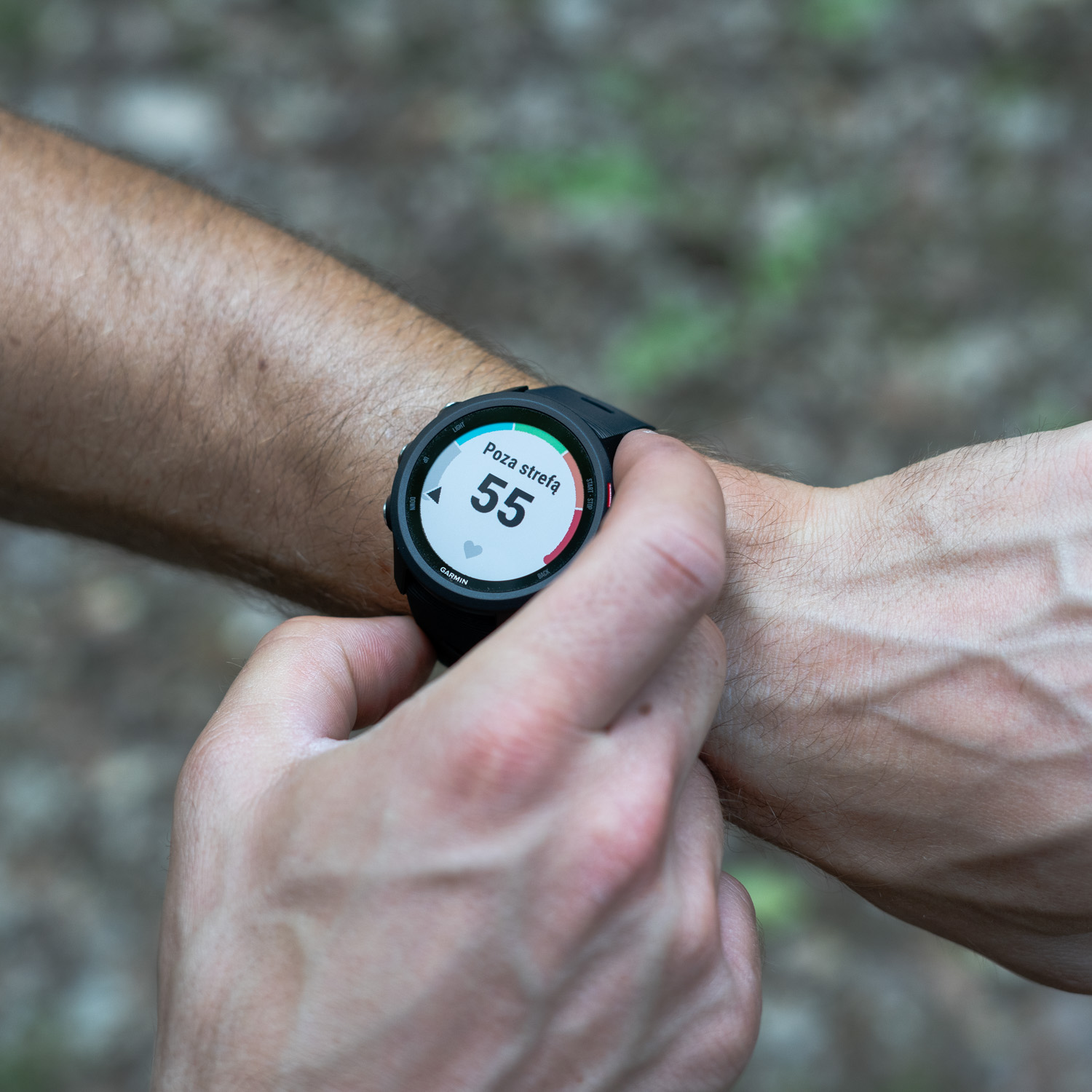
I will write briefly: I have not had an equally comfortable watch on my wrist for a long time. Although on paper 38.5 g is not an overly impressive result, but for some reason I was more comfortable and pleasant - especially for longer periods - than the clearly lighter Samsung Galaxy Active.
It is possible that a lot of plastic finishing will contribute to this (ok, the screen is protected by Gorilla Glass 3), which makes the watch almost undetectable. With pleasure I did not take it off my hand for many days in a row, which can not be said, for example, about the Fenix series watches. Monitoring 24/7 activity? I preferred 245 from my F3. Sleep monitoring? The obvious choice was 245. Registration of trainings? Of course, I preferred 245.
At the same time, Forerunner 245 is not small enough (1.2 "screen, 42.3 mm envelope) to look disproportionate on the average male hand.
Second: perfect control

Let us explain it once and for all - watches that can not be fully and conveniently operated without touching the screen, have no right to be called sports . The Garmin Forerunner 245 happily maintains the layout of five buttons typical of most Garmin watches (two on the right, three on the left) with which everything can be done. There is no other choice - the display is not touch-sensitive.
The only thing I can grapple with is that the buttons - although easy to find and push - do not click as nicely as they do in the phoenix. In my copy, especially the Back button was a bit sluggish in this matter - but that does not mean that it could not be used. As much as it was possible, but it was not so ... satisfying?
Thirdly: a look that does not succeed

In this case, there are two ways to approach this issue for FR 245. Or it is poor, because the whole is made of not very effective, matte plastic, or it is minimalist and is not striking.
For me, the most important thing is that 245 does not pretend to be something that is not. He does not try to experiment with chromed bezelami or shiny plastic (yuck) like Vivoactive 3 Music. It is just a sports watch - made of boring, black plastic, not very fitting to the suit, but not trying to fit it. By the way, made a surprisingly solidly and plastic-looking toy.
Comments? Bezel could be a bit clearer than the surface of the screen to better protect it from accidental knocks. In its present form, this additional protection is rather residual, not to say that it does not exist. And looking at the damage of my nearly 4-year-old Phoenix, I can easily see where and when he got hit. And mostly these were the protruding edges ...
Fourthly: can a runner want anything more?
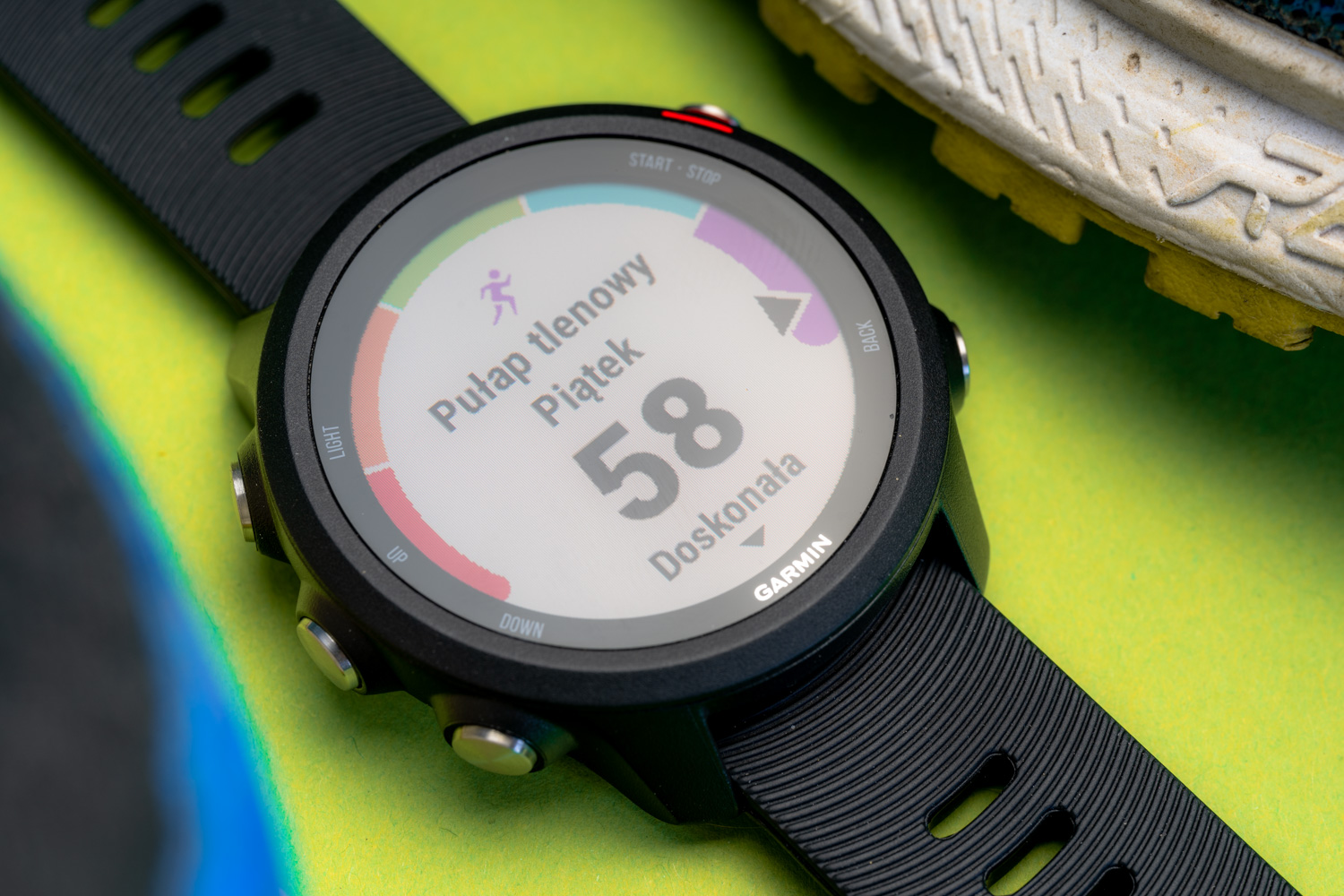
I write this may be the case: the two at the front in the 245 mark is very unfair to this model. Despite the fact that this watch is almost at the bottom of the hierarchy of Forerunners, it does not have to be ashamed - when it comes to running training - neither in combination with 645 nor with 945.
Of course, there are a few more or less significant features missing from these two models, but the set that they offer is more than enough for not only beginners, but also many more advanced runners.
Let's start with the basics - the Forerunner 245 of course supports GPS, GLONASS and Galileo. It also has a built-in heart rate sensor (new system) with an additional function of oxygen measurement (used here to analyze sleep). It also has almost all of the Garmin effort analysis functions in cooperation with FirstBeat. From the estimation of the VO2max level, through the measurement of the training effect (aerobic / involuntary), training load, training status, rest index, round-the-clock effort measurement, up to the prediction / estimation of results for specific distances. Yes, actually all that in the most expensive models - except for the information for 945 and MARQ reserved for how the temperature and altitude affect our performance (but these parameters are still included in the calculation, eg VO2max).
Not only that - if someone has a chest belt with measurement of run dynamics or a separate sensor to measure these parameters, he will see them on screen 245, and later in Garmin Connect, in the summary of the activity. There are also trinkets in the form of Virtual Racer / Partner, sound prompts (sent by headphones), configurable alarms, heart rate transmission to other devices, and so on and so on. In a word - almost everything.
And for dessert, we get an additional security system in the form of automatic or manual sending of emergency messages to predefined contacts. It's amazing that it was not a standard on Garmin watches before.
How does GPS work?
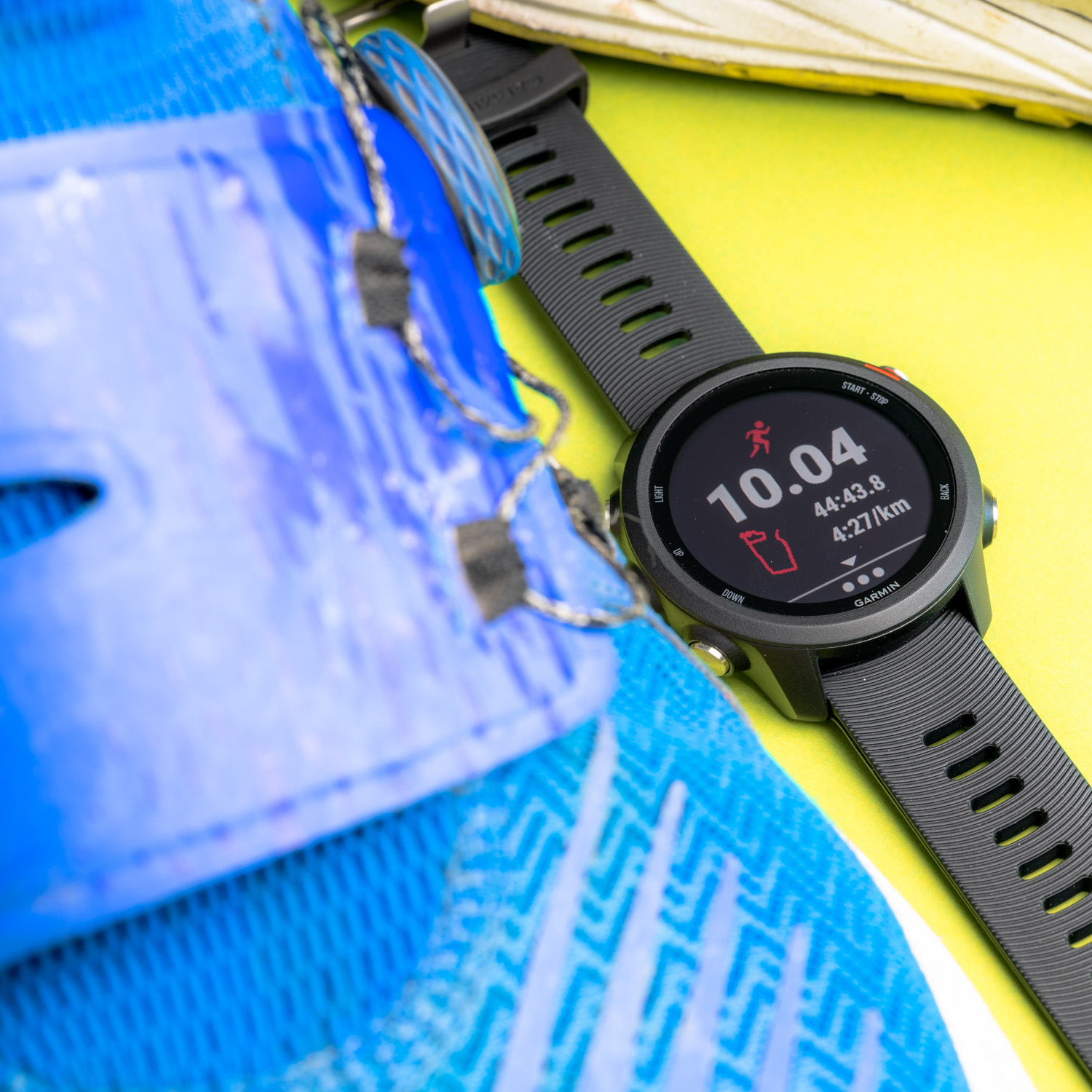
No more complaints - and it's hard to be surprised if the Forerunner 245 has been plastered into a plastic housing that does not degrade communication with the satellites. But time for evidence.
Here, a quiet, about 7-kilometer course, mostly easy for GPS terrain - low buildings and fields. Only at the end (upper right corner) higher buildings appear.
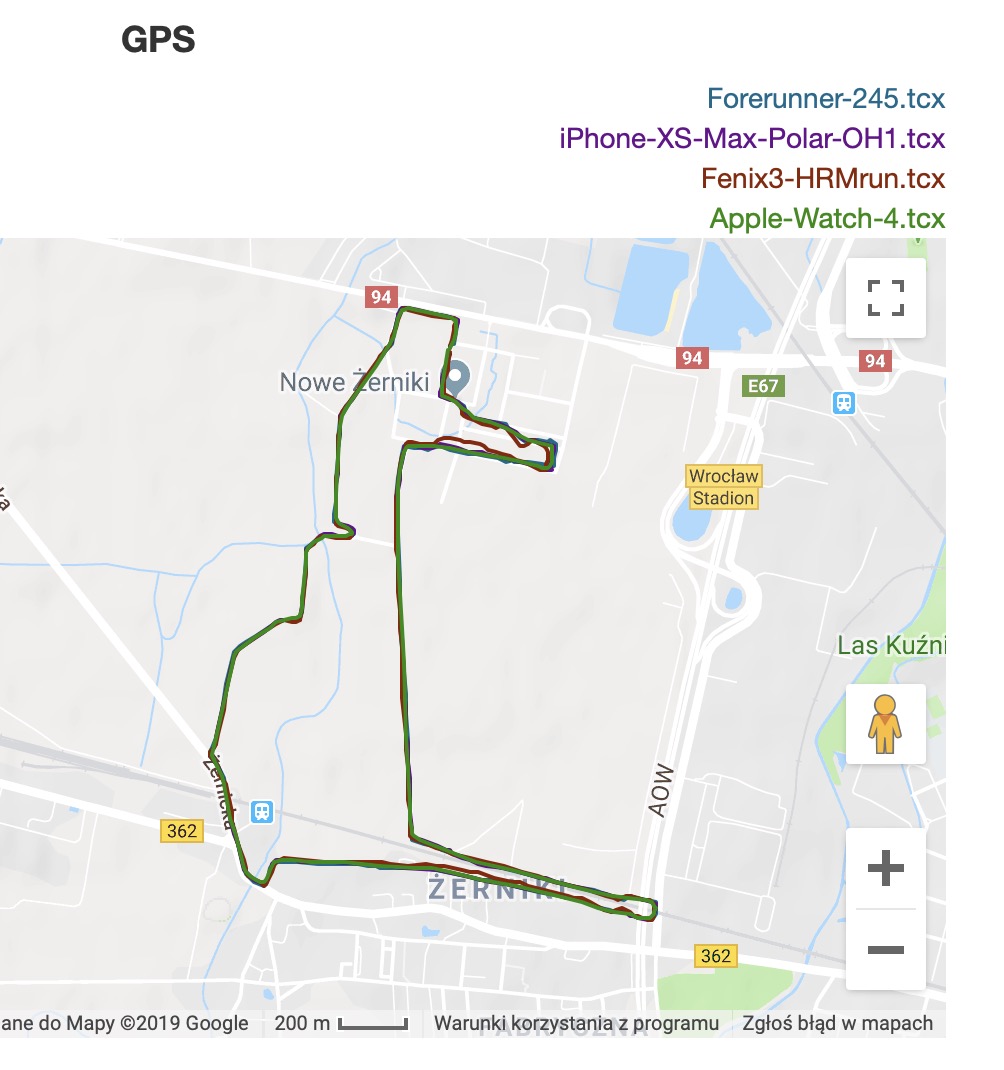
In the open area, virtually all the equipment - maybe except the Phoenix already truncated - 3 are more or less compatible about which way I ran. Apple Watch in a typical way rounded corners, but the whole does not look bad. Forerunner 245, on the other hand, records this fragment almost perfectly.
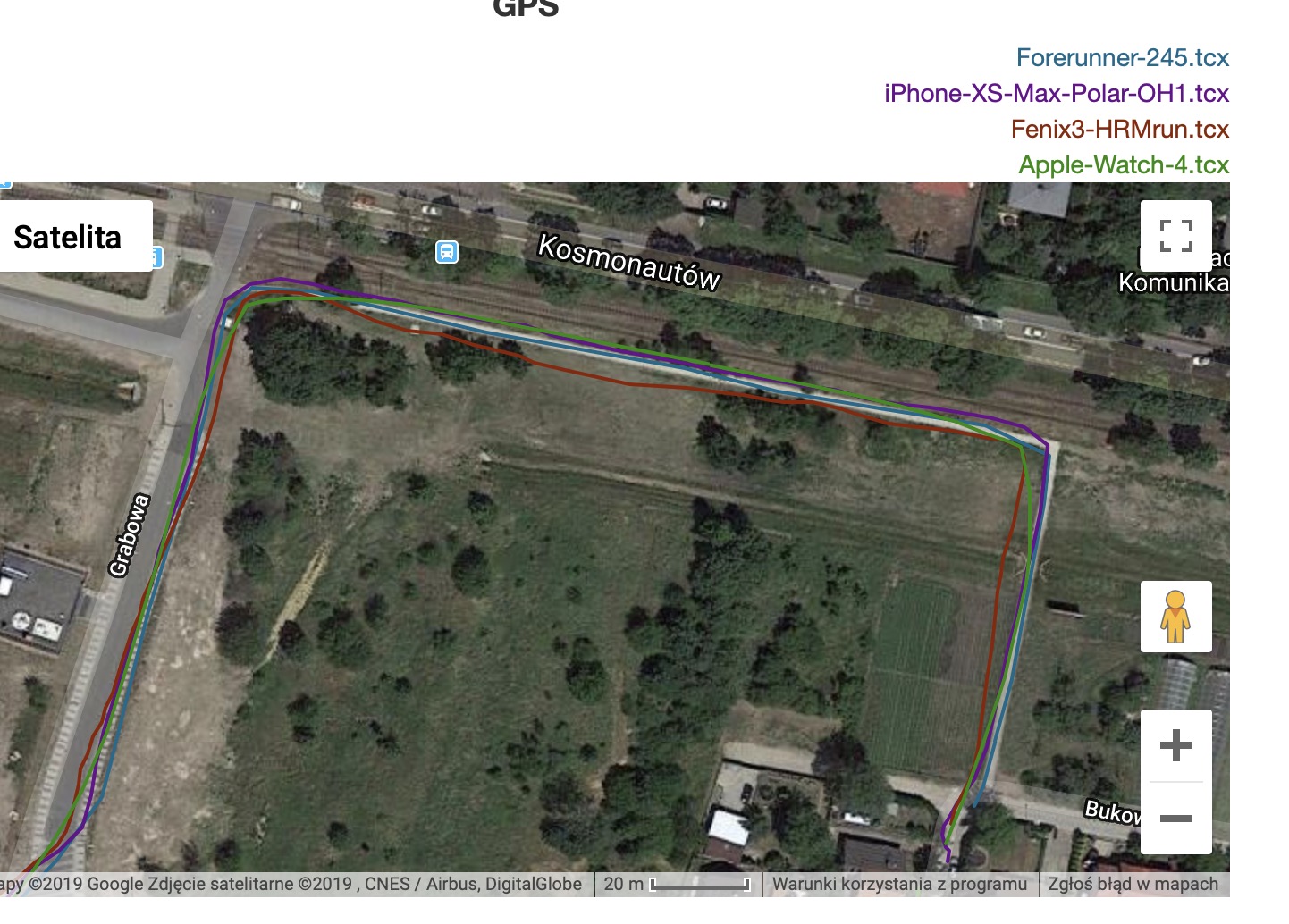
With low buildings, most of the equipment is doing well too. For some reason, they all only cut a bend at the end of the street. Interestingly, the Forerunner 245 cuts it down to the smallest extent:
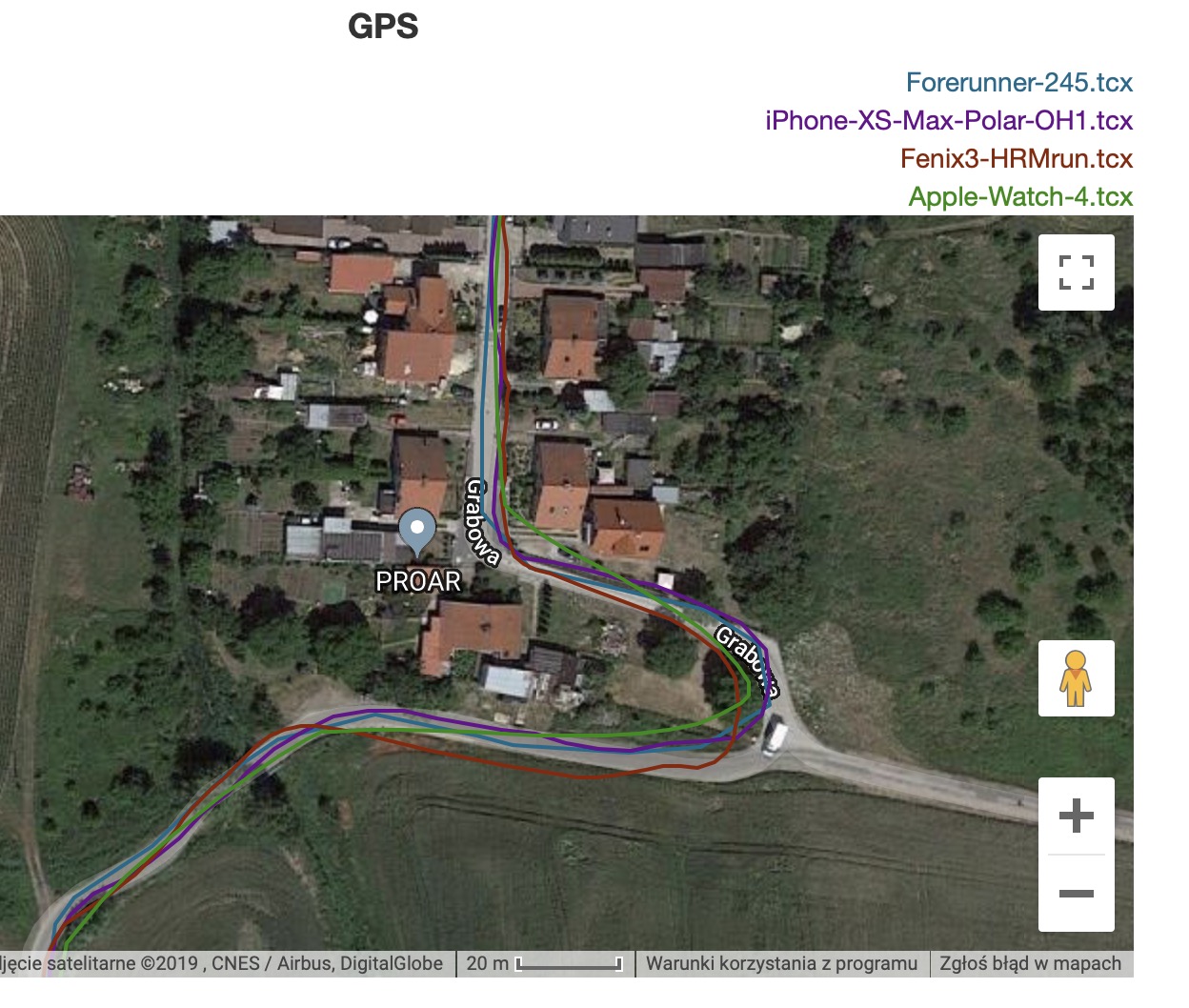
It's fun doing around a large viaduct. For some reason, Apple Watch completely loses count and cuts the bend with a viaduct, while the whole loop under it draws so that it looks nice, and did not have anything to do with reality. Again - the record from the Forerunner 245 is the closest to the actual route, although it also minimally cut one of the corners:
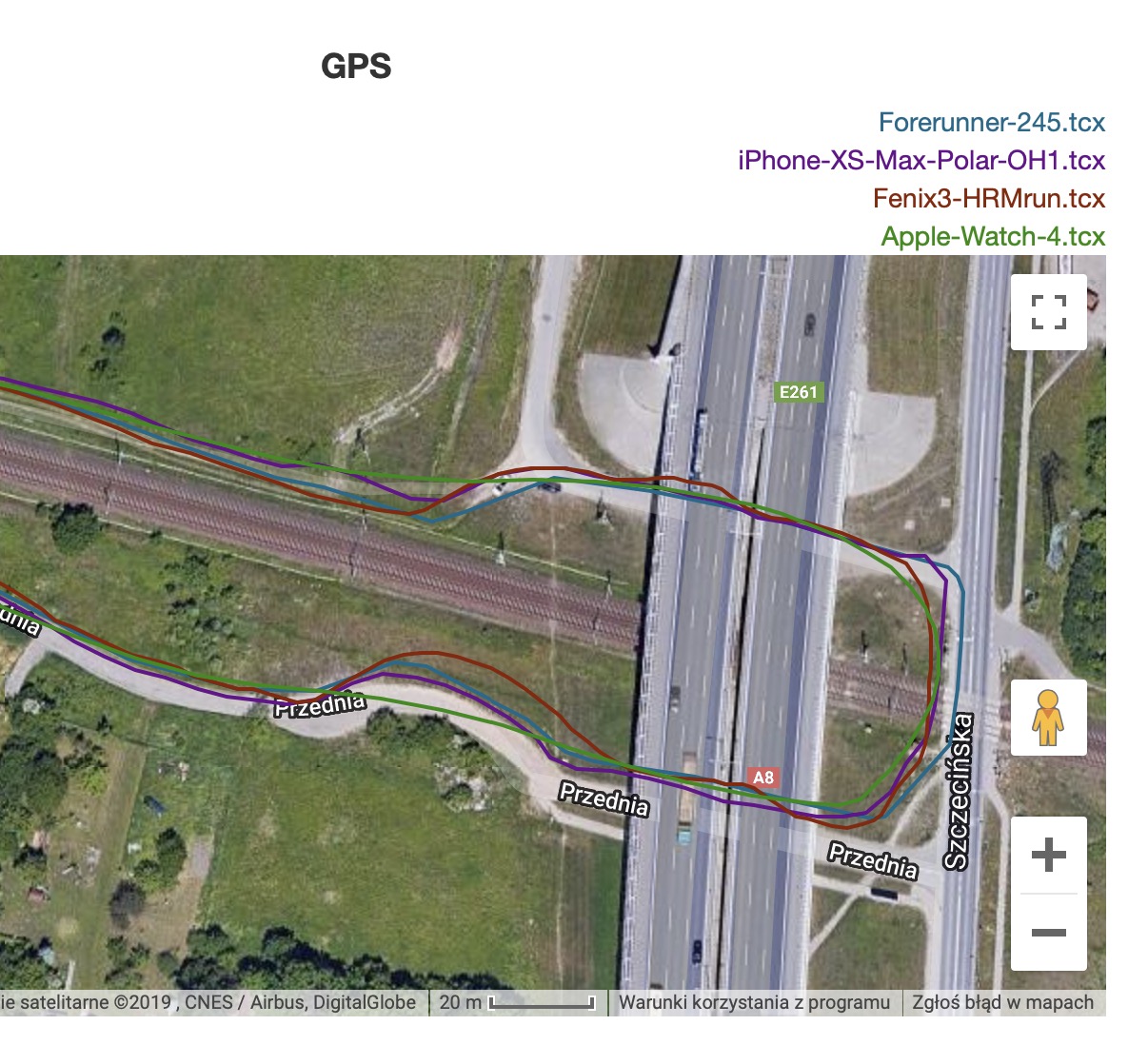
Real fun, of course, begins with a few-story blocks. And if the differences between the entries were negligible, then here they cease to be:
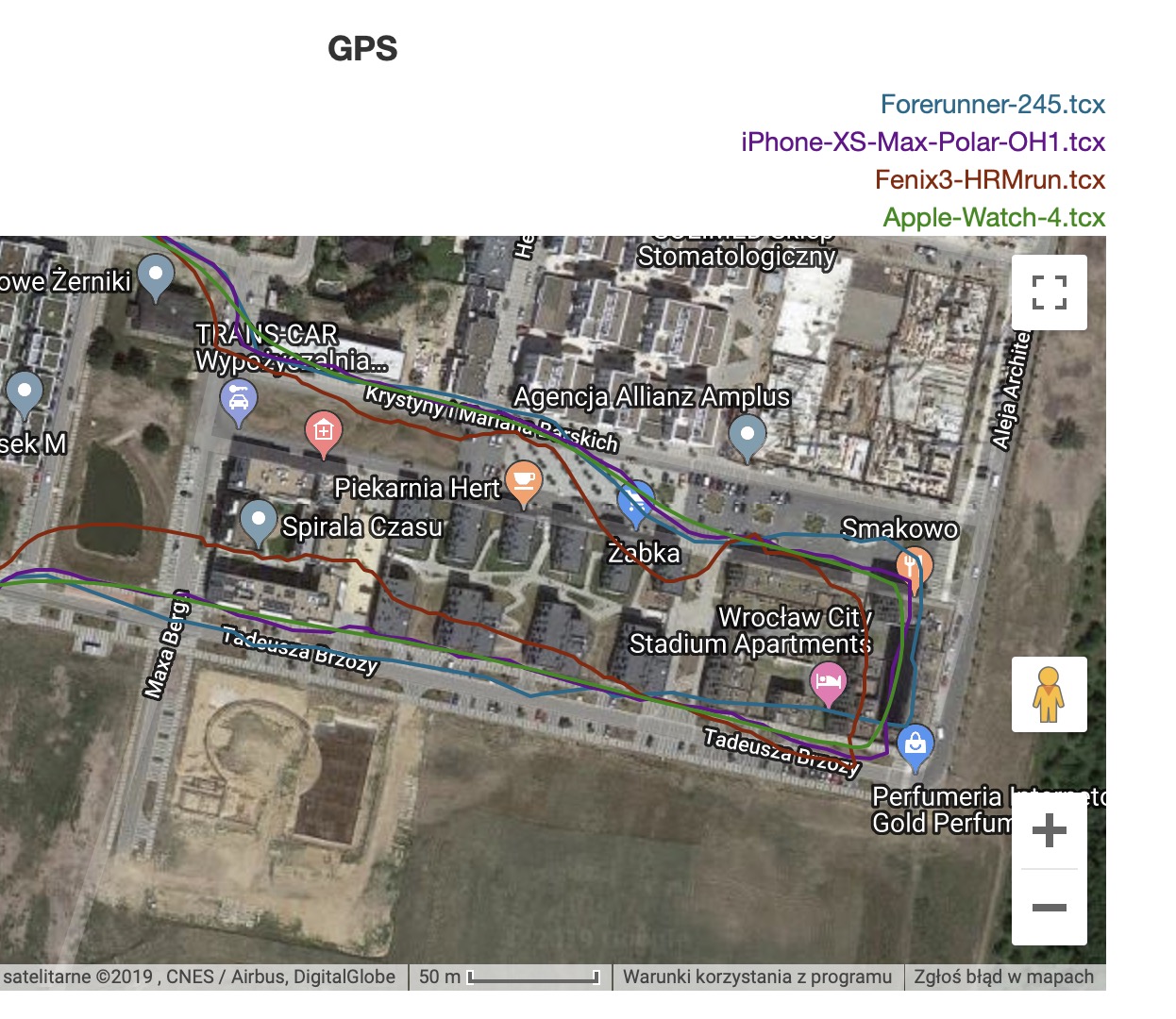
And worst of all - it's hard to say that any of the equipment has really worked really well here. Fenix 3 did not show off at all. Apple Watch and iPhone XS Max have theoretically the best track, but it's still far from perfect. Forerunner 245? Not bad, but a little too high at one of the corners, and in addition, earlier according to him, I was running down the middle of the street.
It's worth remembering that it's all discrepancies in the range of a few meters - finally, the discrepancy between the four entries was 100 m - the least recorded by Apple Watch (6.6 km), the most - the iPhone XS Max (6.7 km). Forerunner and Fenix 3 landed in the middle with a score of 6.68 and 6.65 km respectively.
Similarly, the issue of accuracy was presented during a 10-kilometer walk through the forest near Milicz:

The final result of 245, Fenix and Apple Watch? Correspondingly, 10.53, 10.42 and 10.48. The maximum difference was then about 100 m. If you reject the Phoenix who had the most problems, the difference between the FR 245 and the much more expensive AW is negligible:
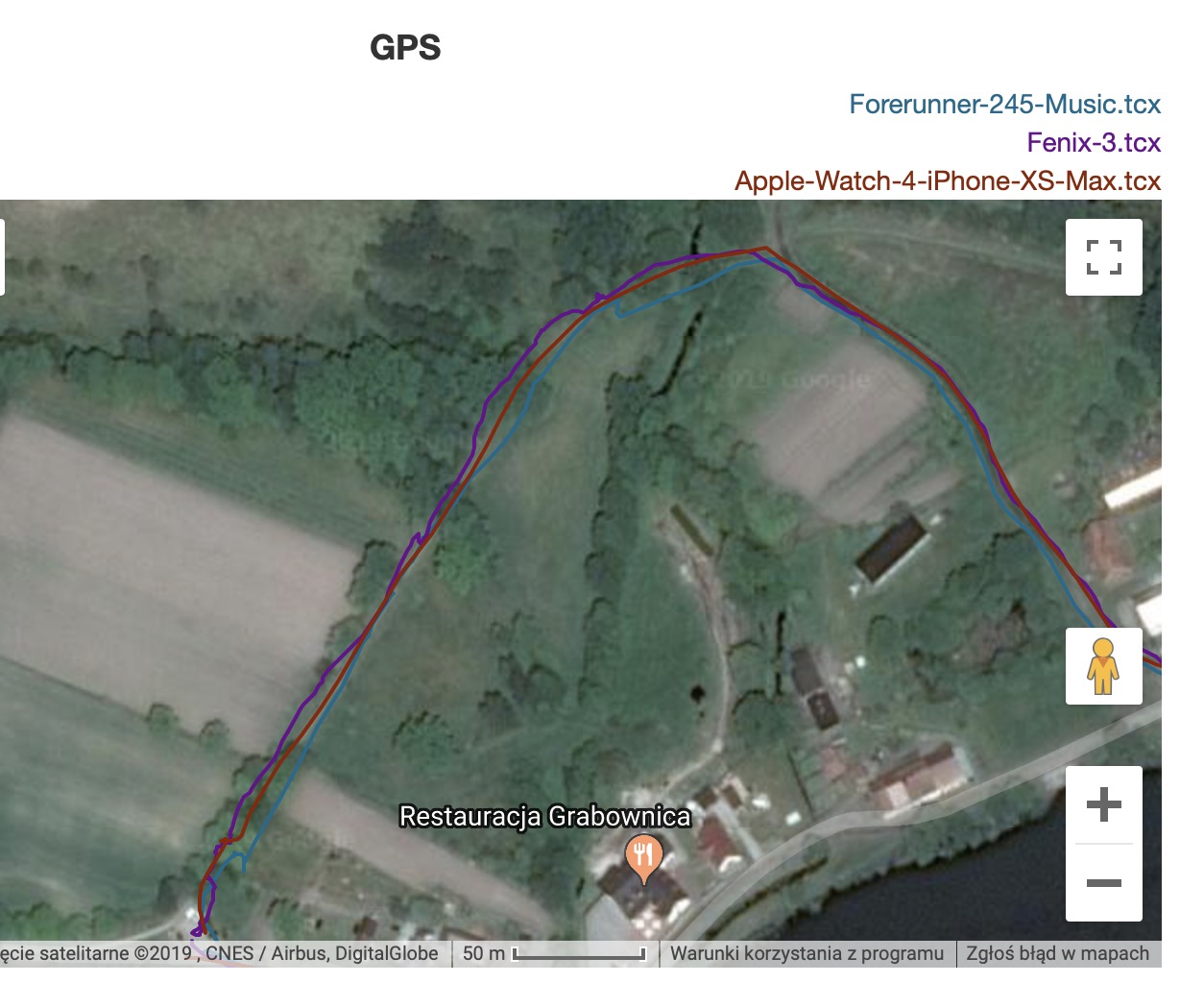
Although I must admit that Apple Watch defends quite well, although at times it too straightens the path. In the case of FR245, we are dealing with a record less pleasing to the eye, but more often consistent with reality.
And how is the heart rate?
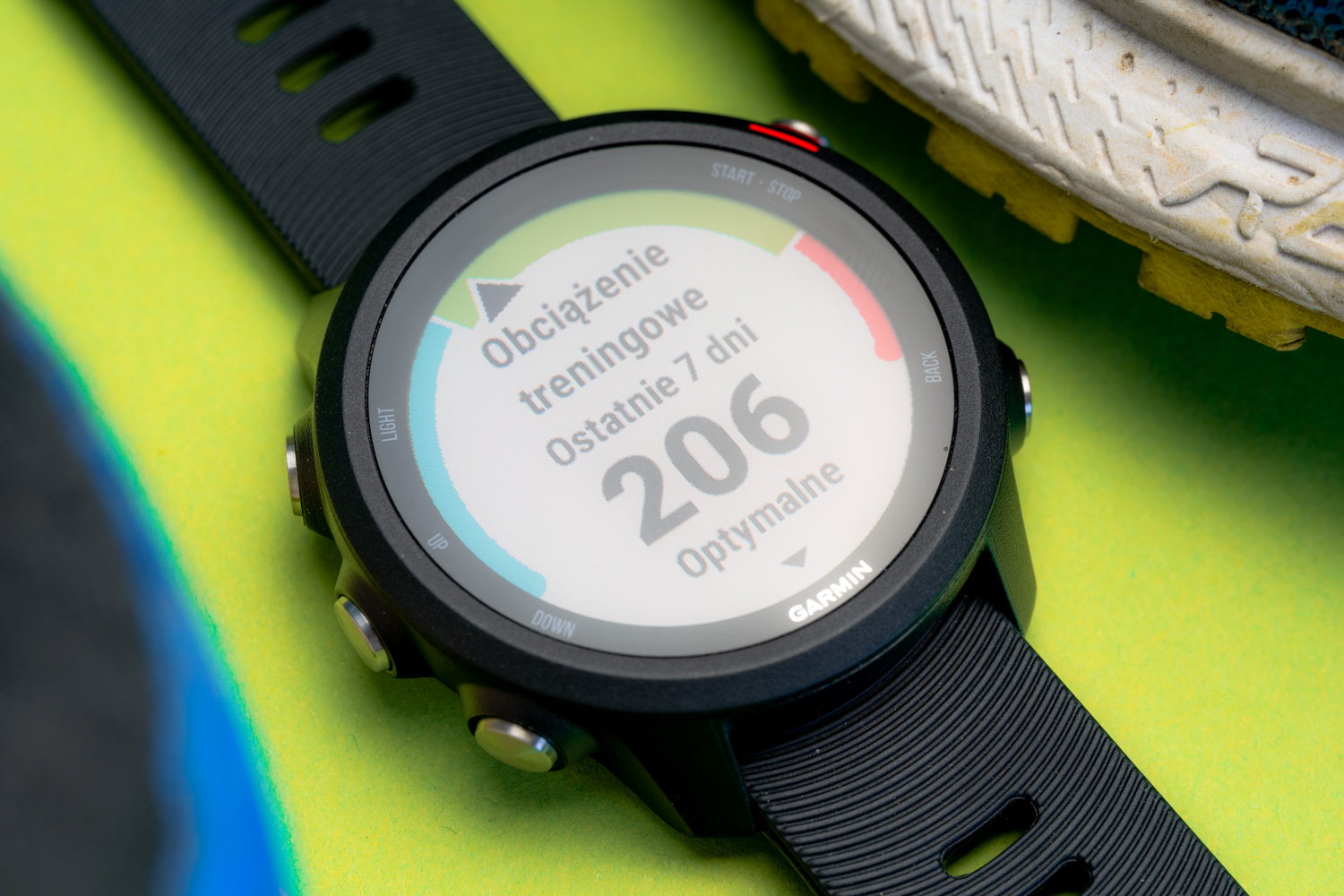
Usually also good or very good, at least if you set up 245 with HRM-Run sensor and Polar OH1. Which does not mean that it is perfect, which is best seen in the chart below with four stronger accents:
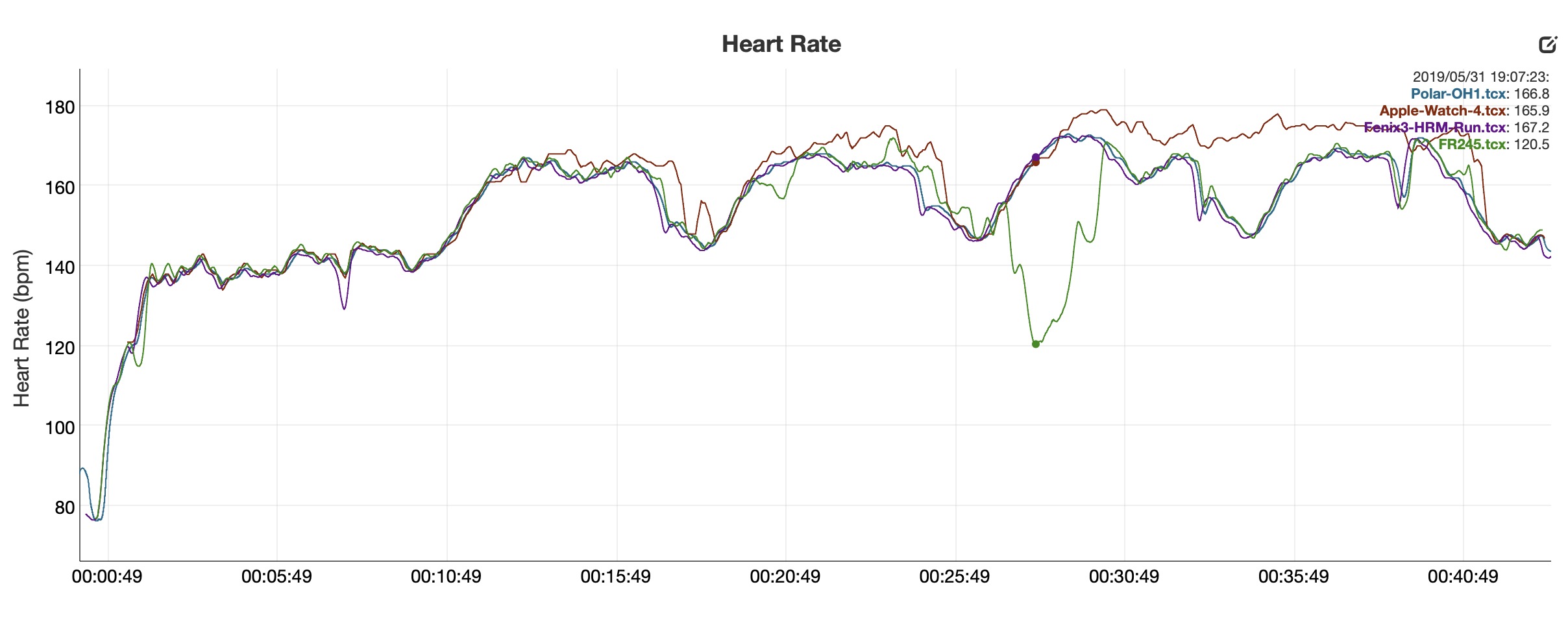
In the initial phase of the run virtually all four measuring devices were compatible, similarly at the beginning of the first interval. Then he began to slowly pour out Apple Watch, not only being late in the rest, but also generating a strange peak in the most rested phase. Later, however, Apple Watch was only getting worse.
FR245, however, began to have problems from around the second interval. First, there was a minimal decrease in the measured value, then a return to normality, and later ... something broke down. I have no idea what, because the position of the watch has not changed, but where it should show about 166 BPM, he showed ... 120. Only a few minutes later he remembered what he was doing (and that he was training)! he behaved properly to the end. Unlike AW, which generated erroneous measurements almost to the very end.
I must point out that this situation happened to me only once during a dozen or so trainings, but only confirms that the old rule is still valid - if you want to have super accurate results from heart rate measurement, you must have a dedicated, separate sensor. Preferably in a different place than the wrist.
Again, however, this is just a single case. During a dozen or so other runs, especially calmer ones, the results of the FR245 were almost identical to those given by HRM-Run.
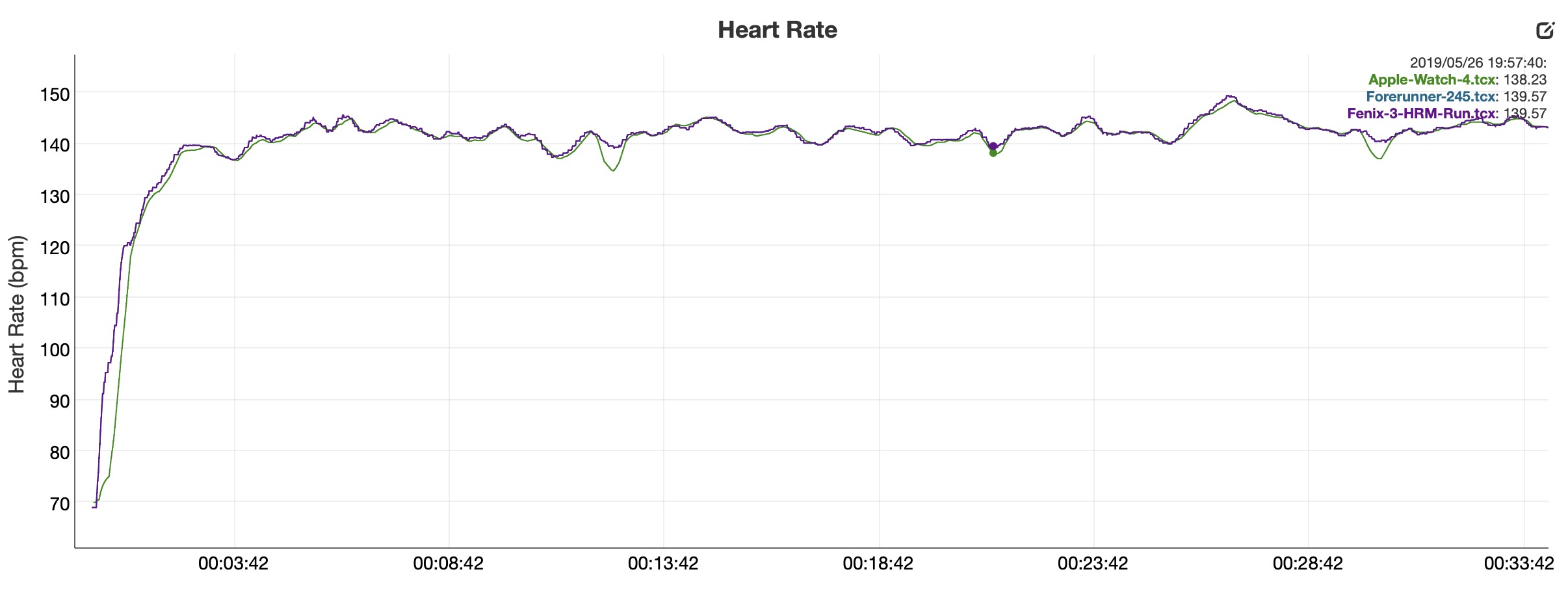
Fifth: Body Battery is not such a gadget-crap
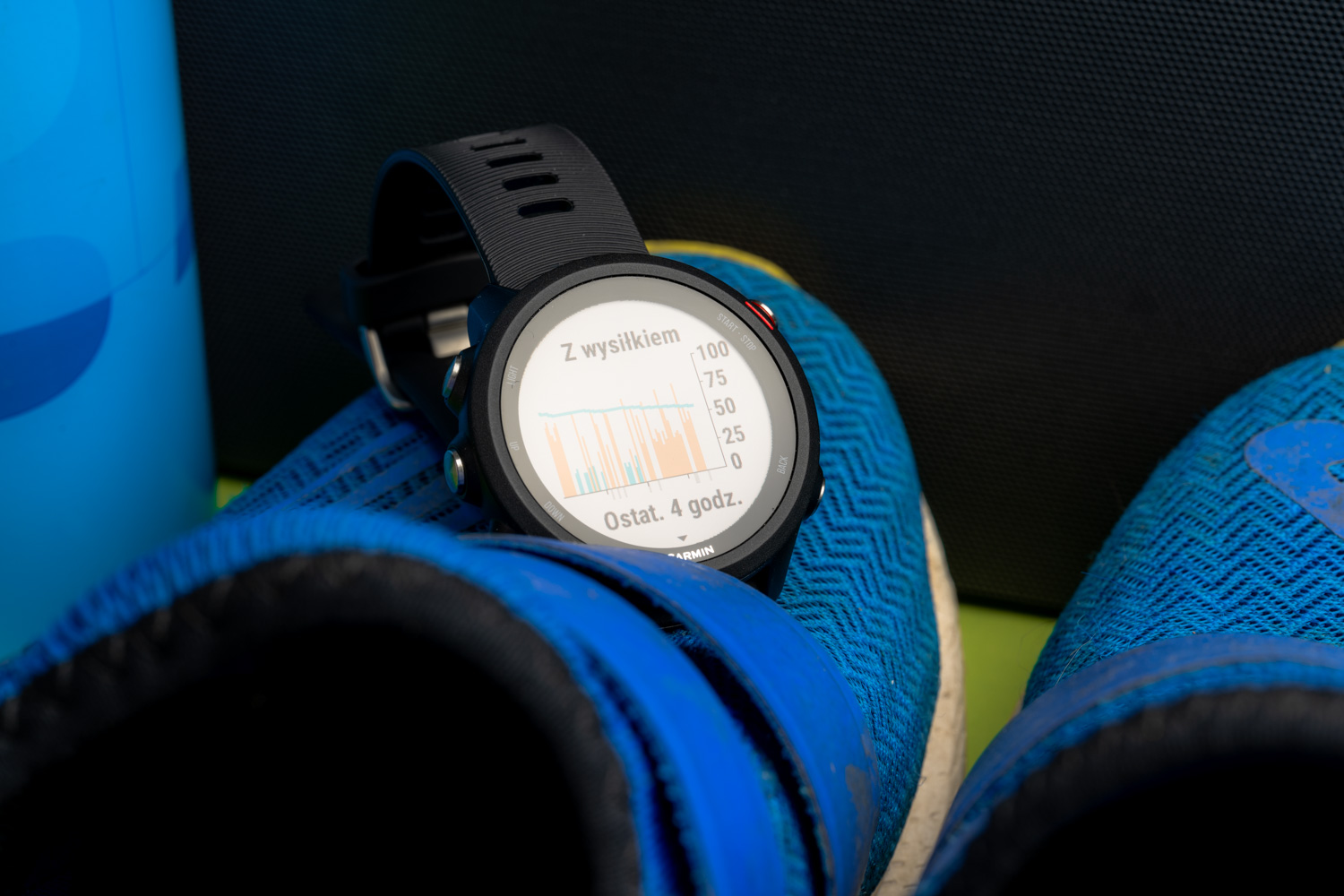
This is not a new feature in Garmin's equipment, but for the first time I have contact with it at 245. And I was convinced that this data is of no use to me. After all, why should I know if I'm tired or not tired? After all, I will not say at work that Body Battery from Garmina stated that I had 20 percent left. energy, so I go to sleep (which is a pity).
For those who do not know if there is Body Battery - it is a function of measuring the energy reserves of the body , which based on the analysis of, among others sleep, activity, effort and HRV determines how much energy is left to us on a given day. And yes - it presents it in a similar way, as does our smartphone in the case of its battery - in percentage.
Of course, the data from the whole day are taken into account. So if we do not sleep well and we do not have a full battery , then we can recharge it, for example, relaxing on the couch. If, however, we provide demanding training, we can be sure that the level of charge will drop.
Is it working? It is difficult to measure it in a scientific way, but - looking at yourself - it is a very precise tool. By precise, I mean here the observation of my own well-being and energy reserves at various levels indicated by Garmin. Over 60-70 percent in fact I still have the spirits and the desire to do things . Around 20% and I fall asleep shortly after placing my head on the pillow, which usually does not happen to me.
On the other hand, the Body Battery indicator itself, as an indicator monitored to check when we are tired, is of course pointless. We know it and feel it, we do not need a watch for over PLN 1000. For this is another interesting solution for monitoring our habits and checking how they translate into our well-being.
Examples? Will the demanding training just before sleep have an impact on our energy the next day? Or maybe we should do something lighter before falling asleep? If I go to sleep an hour earlier and get up an hour earlier, will my day be different than usual? Should I go harder today for more powerful exercises or is it better to do some gentle run-off? Or maybe at the end of the day, after work, I still had so much energy in store, that I should go to run, not to waste these decks?
There are more such examples. Some ideas for recovering or utilizing energy are suggested by Garmin Connect itself. Some of us have to come by ourselves.
Of course, this is not a function that you can not live without. But if you can have it even in the almost cheapest Forerunner - I take it in the dark and I'm happy to use it.
Sixth: Garmin Coach
If you are an advanced runner and run a half-marathon at a rate of 4:20 min / km or better - you can skip this part. If not, the Garmin Coach can be a solution that should interest you.
Just in case, I will say: this is not a 1: 1 alternative for a real trainer who will guide us skillfully throughout the training plan. Probably in this matter, the machines will not replace people for a long time. But if you do not have the option or do not want to take advantage of such assistance, the Garmin Coach can be a great solution.
Theoretically, Garmin has already prepared sets of several dozen training plans for various distances. I use them and unfortunately they have their disadvantages - starting from the fact that it is terribly difficult to move individual trainings in the calendar, so as not to smash the rest of the plan, and ending that they give rather little fun to finish the next stages and do not adapt to our progress during training. They are once entered into the calendar and at the end - regardless of how we handle each other.
And again - Garmin Coach does not make any debuts at FR 245. I had contact with him before, but then only training plans for 5 km were available, so I did not really want to test it. Now the range is from 5 km, 10 km to the half-marathon. For each of these distances we can prepare training for a maximum of 4:20 min / km.
Is the Garmin Coach different from the classic Garmin training plans? First of all, the whole is adapted to our training results. At the beginning we ask the planned distance and pace in which we want to overcome it. Then we go for a short and fast run that will help Garmin pre-evaluate our abilities and create the start of the plan. Subsequent trainings appear in the calendar only when the software collects enough data.
With all of this, we will find detailed instruction in text and video form for each of the trainings, from which we will learn that, for example, we have to run fast but not so that we feel that we are dying . The whole is also decorated with a certainty of certainty - that is, a shortened information about whether we will probably achieve our assumed result, or whether we train too little and too little to achieve the goal.
And no - Garmin Coach is not a perfect solution. It has a few holes and shortcomings that you have to deal with yourself. But until I started to regret that my current watch does not support Garmin Coach.
Seventh: not just running
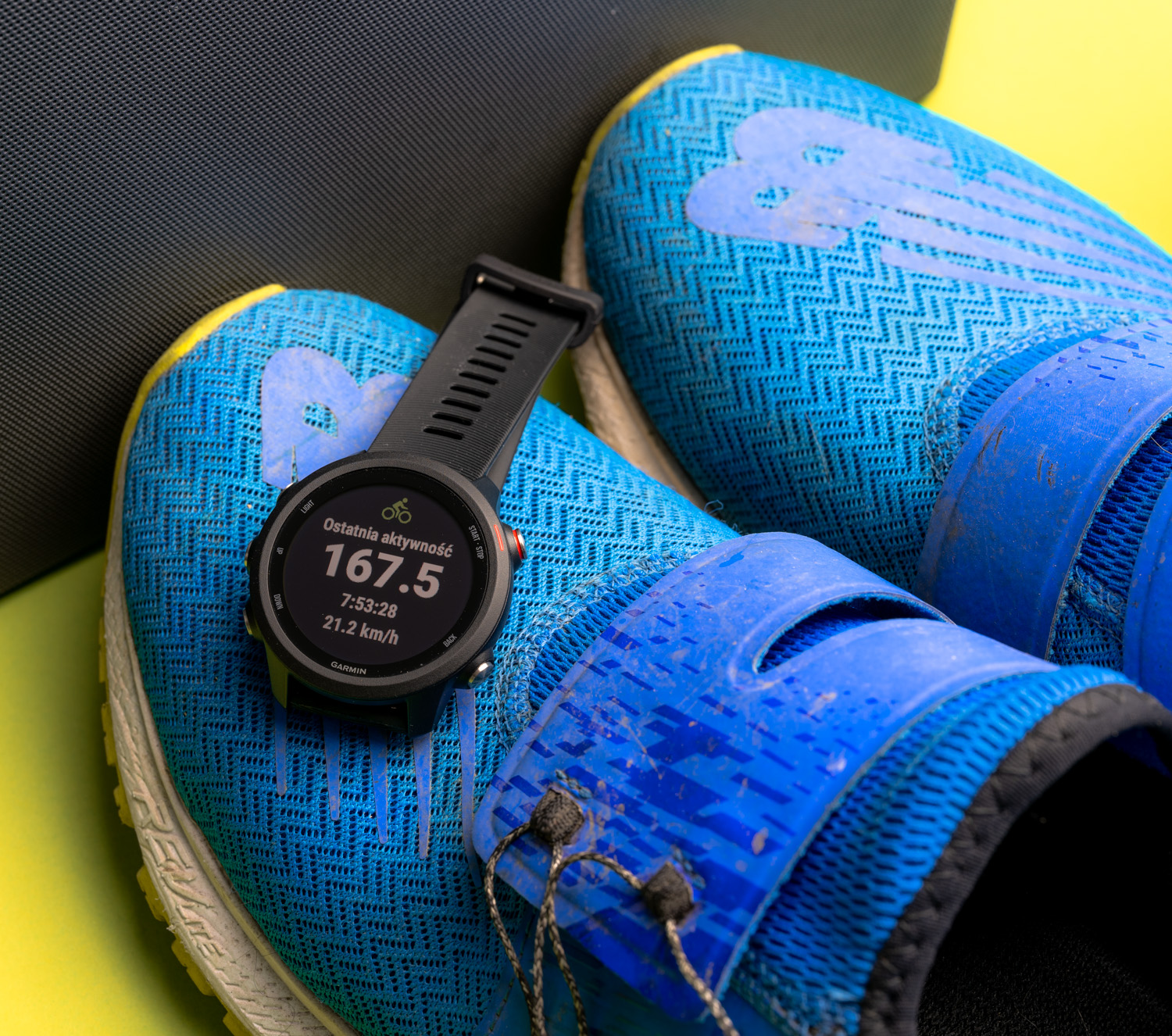
Like a runner in the name, but luckily the time has come to an end when the Forerunners could only monitor running. On 245 we can also find separate sports modes for:
- gait
- walking on the treadmill
- running on the treadmill
- running on the indoor track
- running along the trail
- bike
- cycling in the room
- swimming at the pool
- ergometer
- strength training
- cardio training
- yoga
- elliptical machine
- stepper
And the universal category "Other". Some items are missing (more on this later), but the basic ones are the most. You just have to remember that 245 does not have a function to combine activity, so it's not a triathlon watch.
Eight o'clock: the basic smartwatch will also work
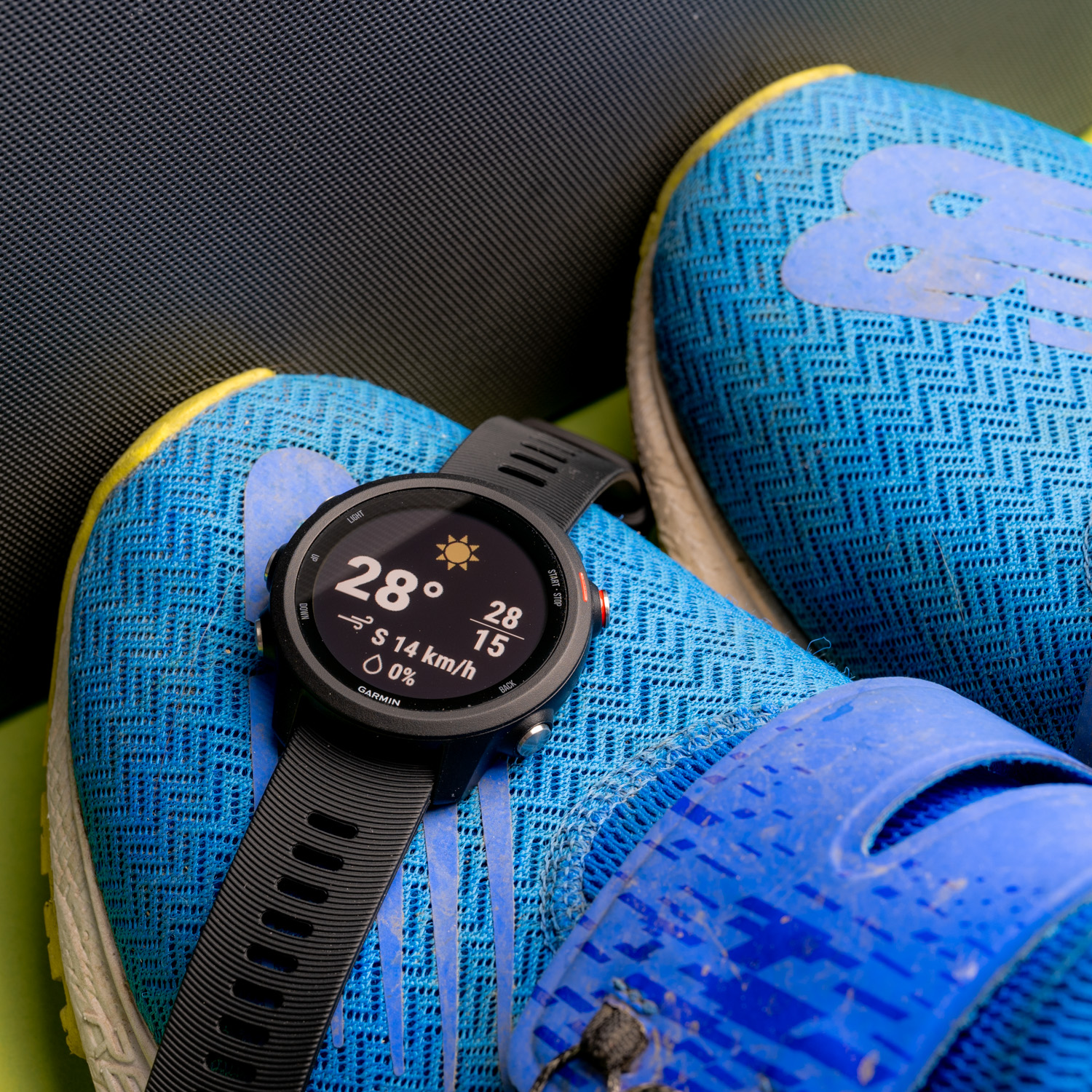
Notifications? Are. Music? In the Music version, we support Spotify or Deezer (including the option to save the watch, memory: approx. 500 songs, BT connectivity with headphones), while in the version without Music we can control the music from the phone. Weather? Is. Additional applications, eg for controlling Hue lighting (in an unofficial version)? Are.
Of course, there is no discussion here - the Garmin Forerunner 245 does not reach the heels in terms of smart functions, for example Apple Watch. There is not the slightest chance, both in terms of system solutions, as well as the availability and quality of applications.
But if we want to have a very good sport watch with sufficient smart functions, then there is no need to look at other products. In turn, if we are looking for a very good smart watch with simple sports functions - it is better to look elsewhere.
Ninth: do not scare the price
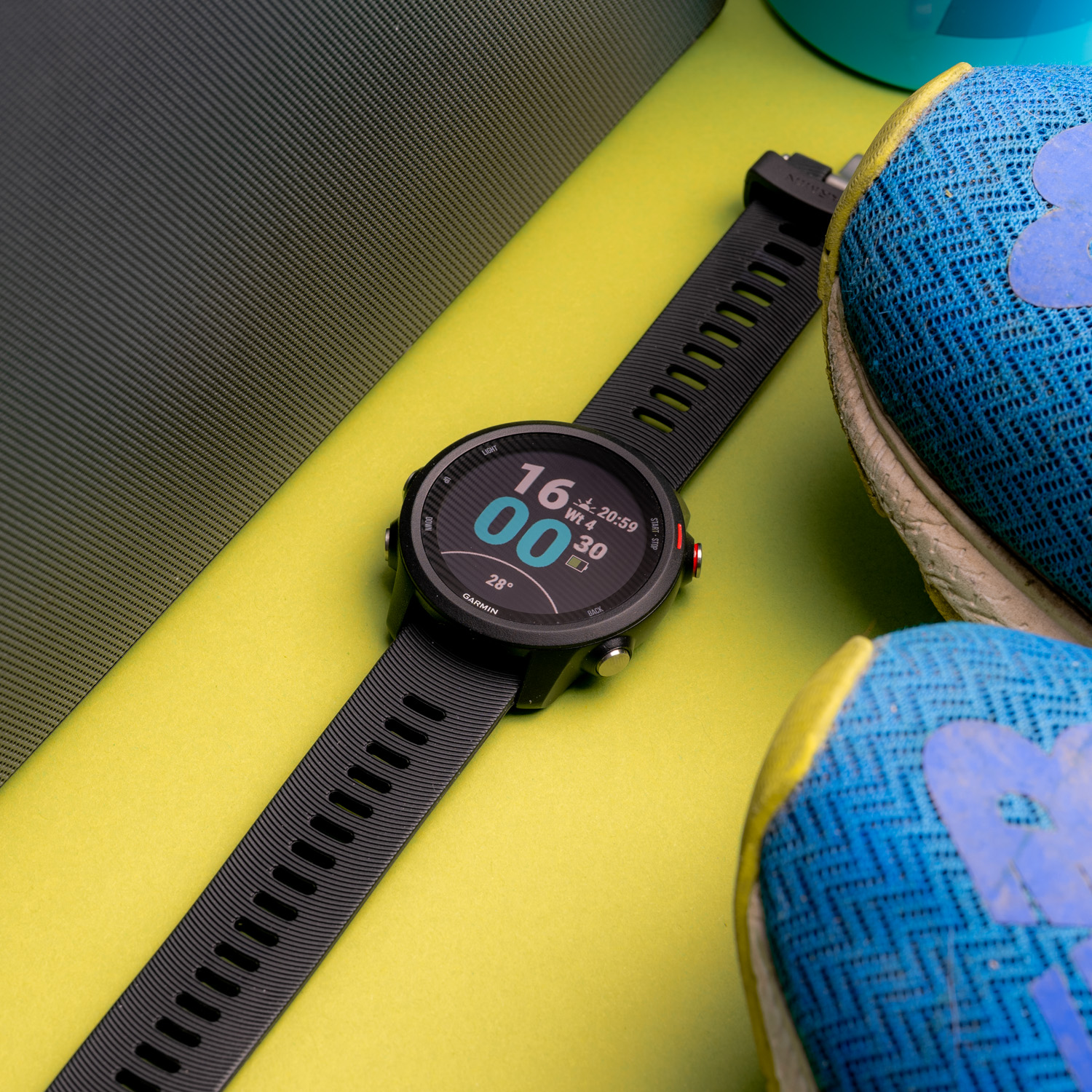
This is a relative issue - the Forerunner 245 version without music costs about 1350 PLN. In the version with music - about PLN 200 more. And no, it is not overly cheap, and it is not an expense for every budget.
On the other hand, it's almost the cheapest (below are still 45 and 45S) Forerunner in the Garmin range. Noticeably cheaper than 645 and twice (!) Cheaper than 945. And at the same time - if one is mainly running - absolutely not twice as bad.
I admit that for some time I have been wondering what to mention my Phoenix. Initially, the plan was to wait for the premiere of Phoenix, put off the money until then and again buy the best and the most expensive . However, I look at this 245 and I am not sure how I would be able to justify the release of over 3 thousand. PLN instead of 1.3 thousand zł. 245 is so good - and certainly enough for years (almost certainly - about what in a moment).
Tenth: screen
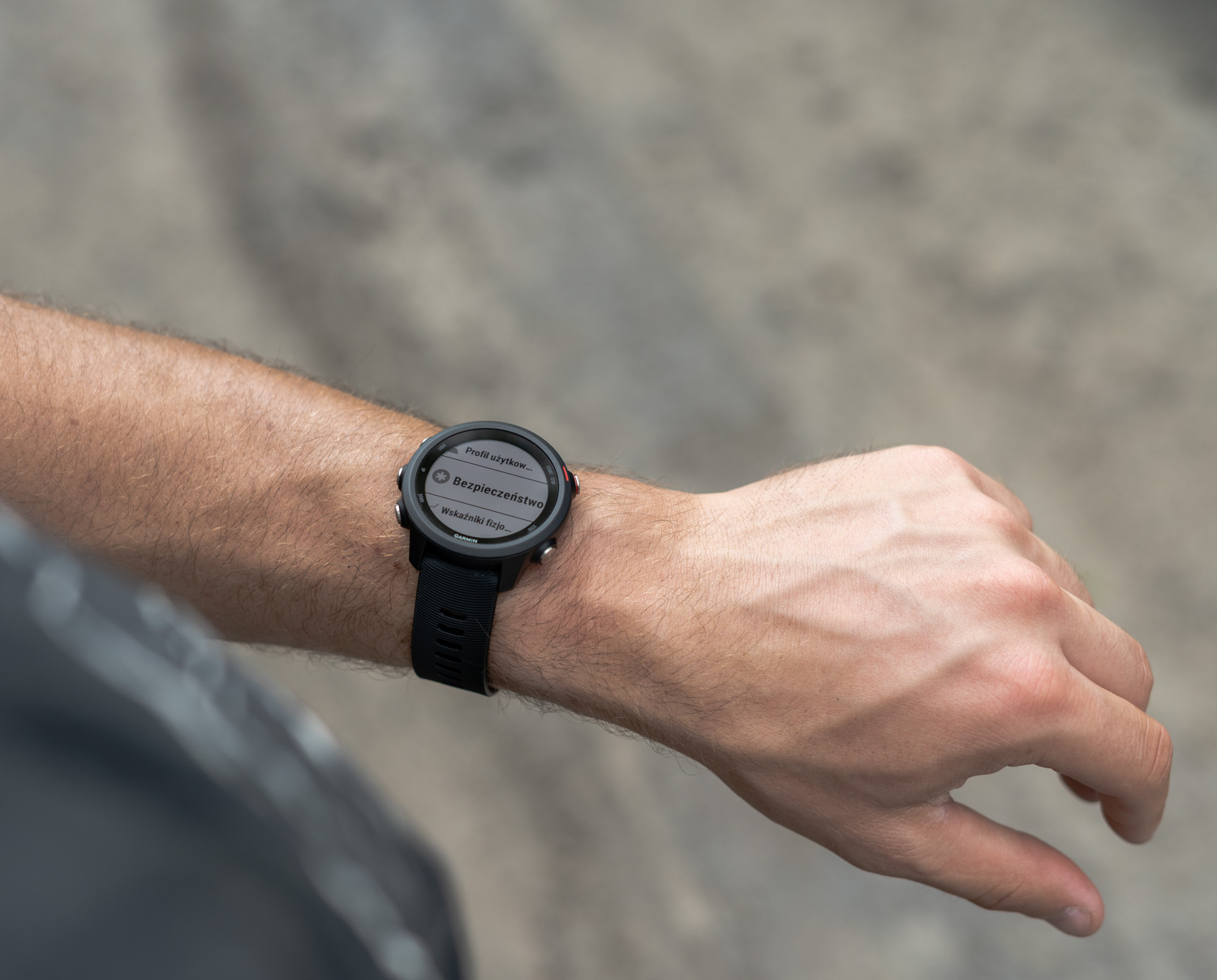
It is not beautiful (only 240x240 pixels). There is no start to Apple Watch or Galaxy Watch. But it has two great advantages.
First of all, it is always illuminated, and secondly, it is perfectly readable in the sun. What more do you need from a sports watch?
Eleventh: the battery
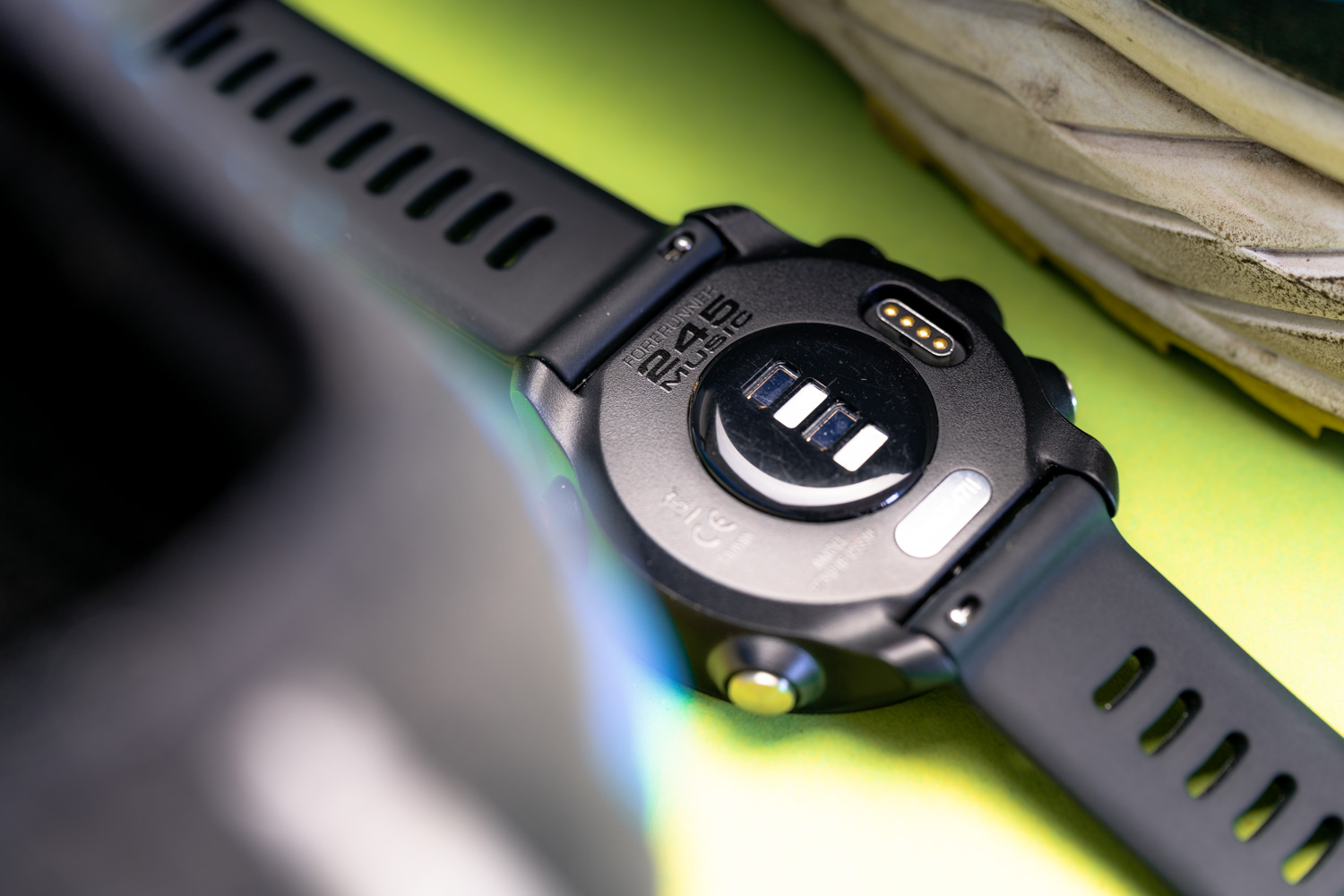
Rather, no one will be surprised that 245 will withstand more than almost any smart watch, so I will quickly quote the most important data - 7 days in watch mode, 6 hours with GPS and music, 24 hours with GPS without music. But this is not the most important thing.
The most important thing is that in 245 came - and this is a big surprise - UltraTrac mode, which is an ultra-efficient mode of logging activity. Using it, we should get significantly more than the standard 24 hours (it is not known yet exactly). So if someone, for example, plans to run for more than a day - yes, he can take FR 245.
What is wrong?
Where is the barometer?
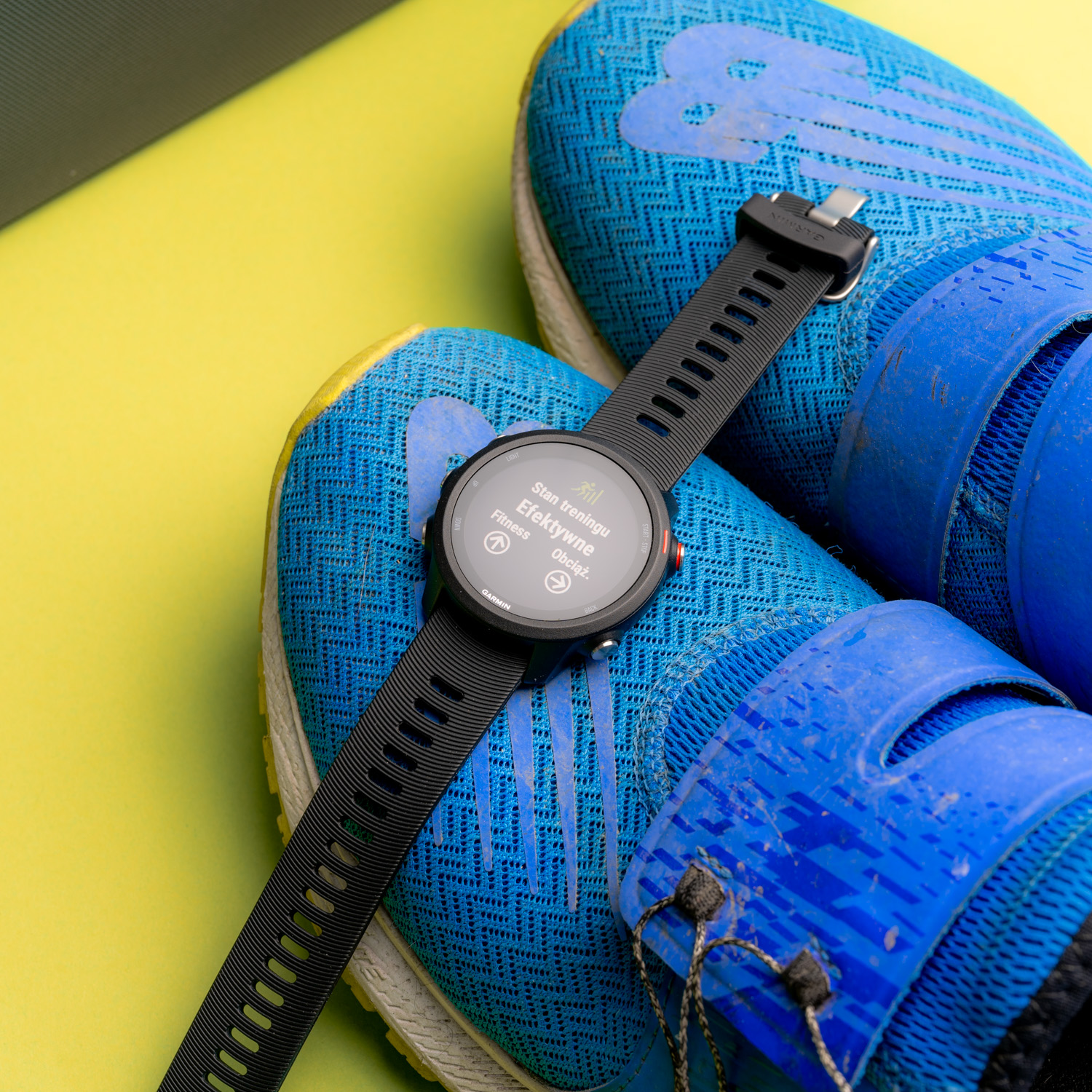
This is actually the main reason why I have not yet jumped from 1350 zlotys and I have not ordered 245 yet. For while I run mainly flat (such surroundings), I regularly roam the mountains and like - on the planned route - have a detailed preview of it, how many approaches have I left and how many approaches have I left. ClimbPro is not necessary for me, but basing on altitude from the map and GPS is not always 100%. effective.
Added to this is the lack of measurement of the number of floors covered during the day. Yes, a trifle, but since everyone is trumpeting that entry is important, it is a pity that this parameter would be missing.
And since we're already entering ...
Where are the hiking trips?
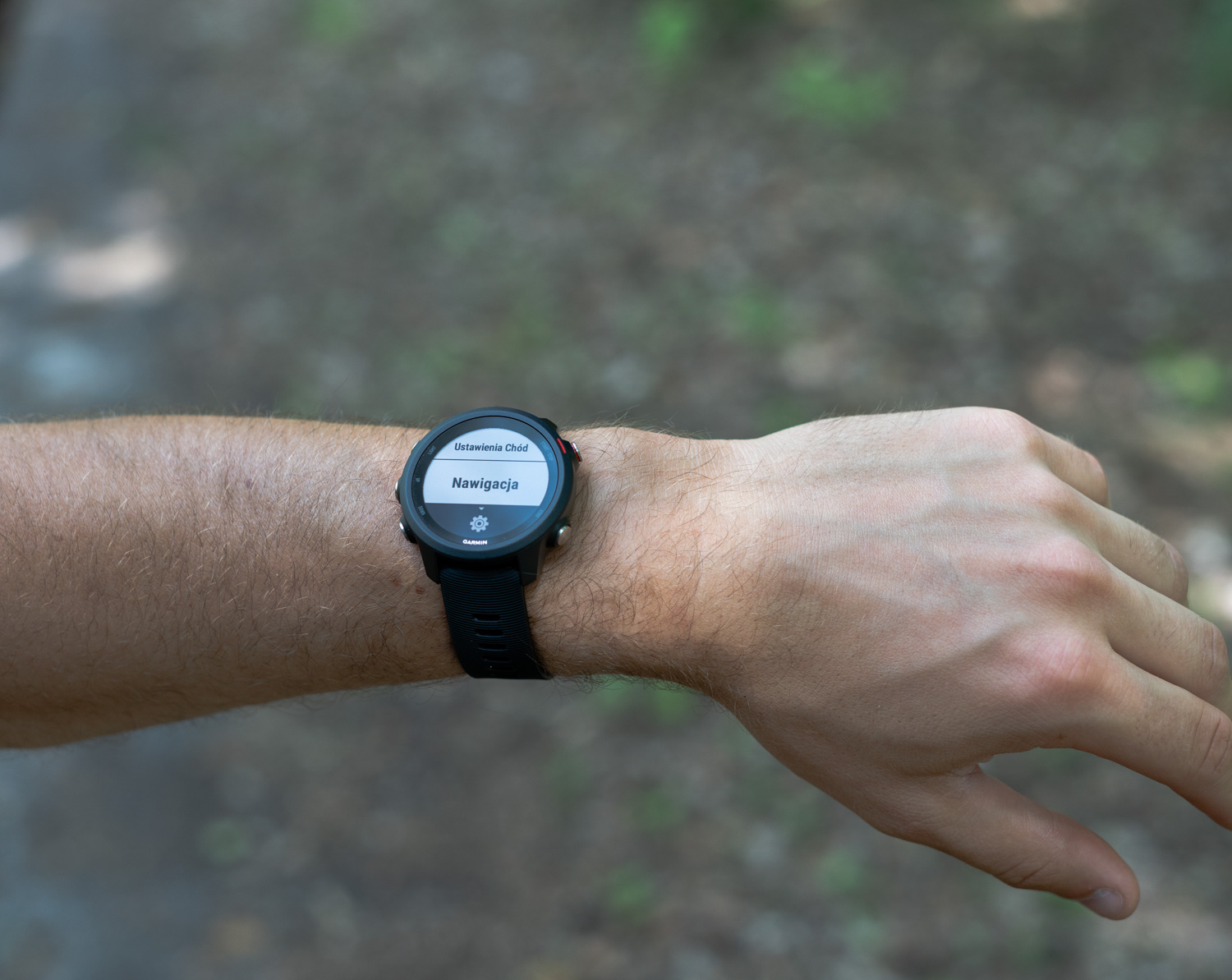
This is an issue that I will never accept. Because when it comes to understanding, I understand what's going on - for money.
Forerunner 245 is a watch - even the name itself - designed for runners, which can also be seen from the list of available activities. Yes, there is cardio, there is strength, there is some walking. But no longer hiking or skiing.
And that's why in the title I wrote that it is my favorite watch running, possibly also sensible for a bike, but otherwise its use is limited. You can go with him in the mountains, but no one will force me to buy a watch for over 1.5 thousand. After each transfer of activity to Garmin Connect, he had to change the Walking Walk manually. It is possible to get around with external applications, but I'm sorry that Garmin can not give a full list of activities and that's it. Sure, he can not monitor some of the important parameters for them on 245, but let this be the user's choice.
For consolation - Forerunner 245 has trace navigation options. Ie. TrackBack and return to start. Of course, we can not create a route plan with directions in this way, but it's always something.
All other shortcomings
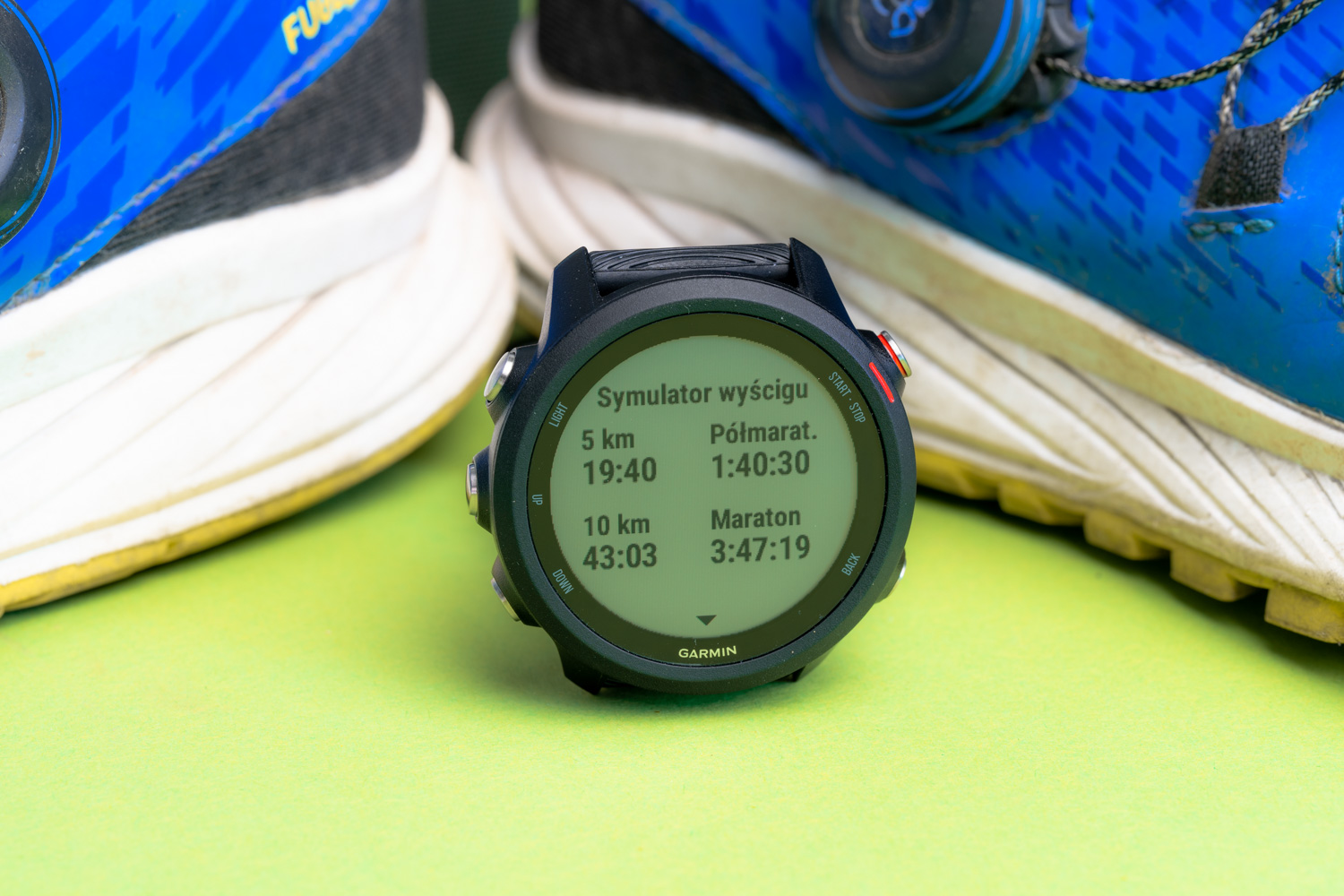
There are a few of them, but in this price range - as for Garmin - it's hard to fault them.
Of course, some may miss maps, but then you have to reach 945. Some may lack segments, payments or barometers, but then you have to go at least to 645. Also, a little Garmin Pay is missing, although this system is currently available in a limited number of banks in Poland.
Worth it or not?
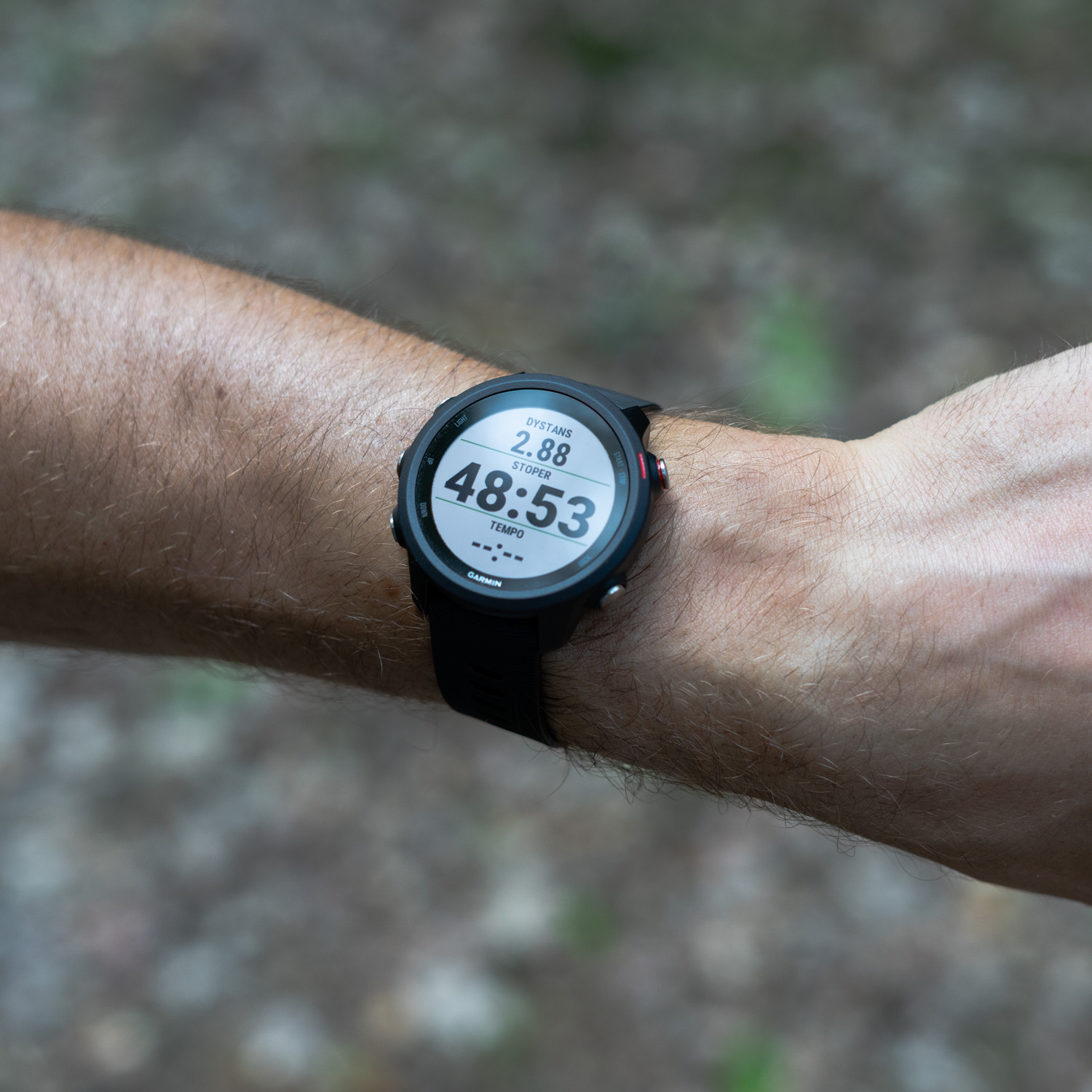
All you need to do is answer a few questions:
- Do we care about accurate height monitoring and changes (barometer)?
- Are we mainly running or is it one of our many activities?
- Do we want a nice watch or a comfortable watch - one that we can carry on our hands for many days without the slightest problem?
If we do not need a barometer, we mainly run and want to have a comfortable running watch, the answer is simple - if we have 1350 zlotys to spend on a sports watch, which also works well as a basic smart watch every day - buy. Buy and not regret, because Garmin did a really great job with the design and implementation of 245.
Will I buy 245 myself? I'm not sure yet. On the one hand, reason tells you to do it. On the other hand, the heart tells you to throw yourself at 945 ...
My new favorite running watch. Garmin Forerunner 245 - review
Comments
Post a Comment